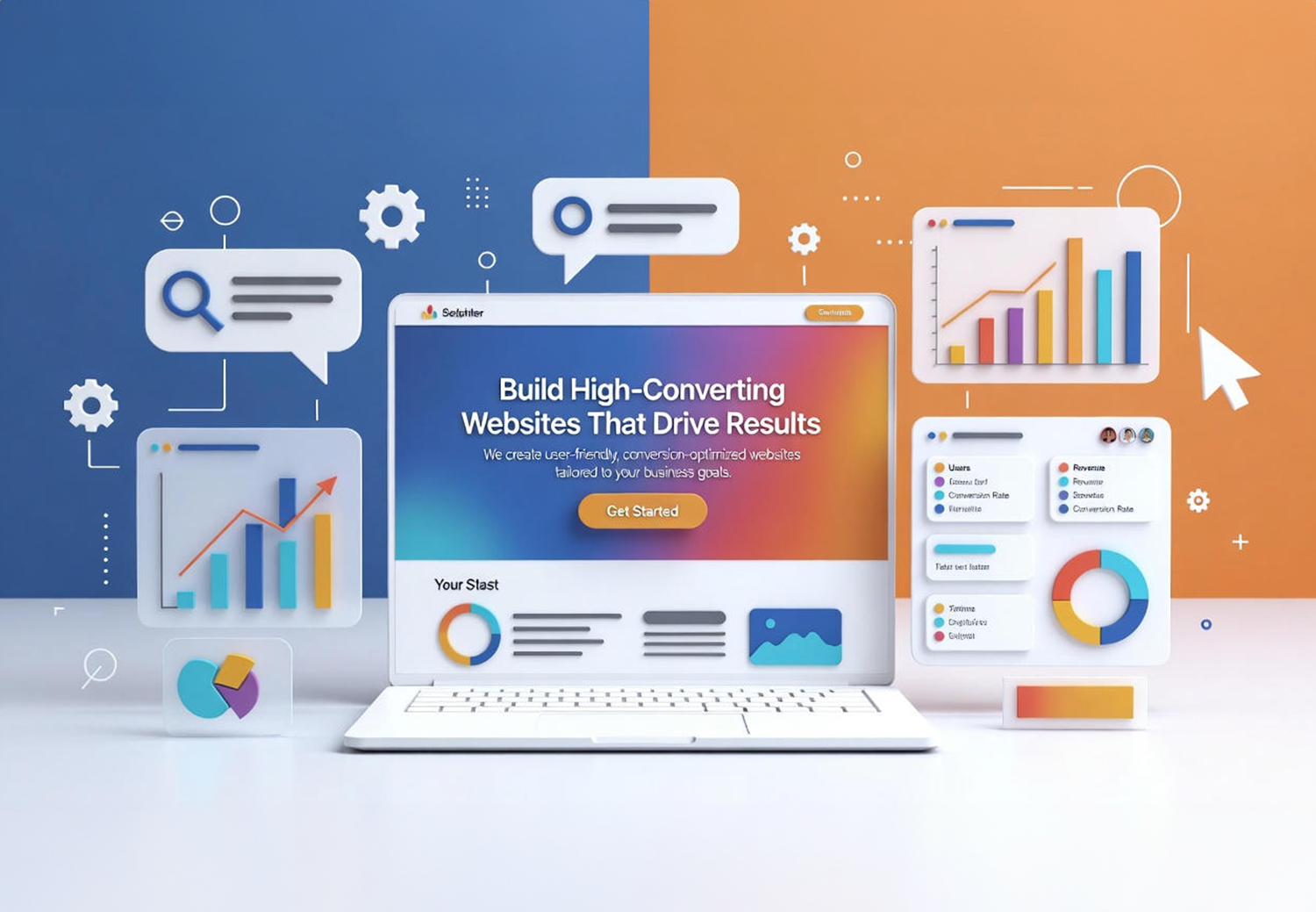Work Hours
Monday to Friday: 9AM - 6PM
Weekend: Closed

Have you ever wondered why some websites effortlessly convert visitors into paying customers while others struggle despite great traffic? The difference often lies in design and usability — not just aesthetics but how effectively your website guides users toward action.
In today’s competitive online world, having a visually appealing site is no longer enough. Businesses need high-converting websites — platforms designed strategically to attract, engage, and convert visitors into leads or sales. Whether you’re running a startup, eCommerce store, or a growing enterprise, your website serves as your digital storefront and sales engine.
In this blog, we’ll break down 10 must-have elements of a high-converting website backed by UX/UI principles, SEO insights, and real-world examples that drive measurable results.
1. A Clear and Compelling Value Proposition

Your website’s first impression can make or break a potential lead. Within seconds, visitors decide whether your site is relevant to their needs. That’s why having a clear, concise value proposition is crucial.
Your homepage hero section should instantly answer:
- What does your business do?
- How does it help users?
- Why should they choose you over competitors?
For instance, Slack communicates collaboration and productivity in a single line — “Slack brings the team together, wherever you are.” This clarity eliminates confusion and builds trust.
Tip: Use your primary heading (H1) and subheading to highlight your service’s benefits in plain, customer-centric language.
2. Intuitive Navigation and User-Friendly Layout
Even the most stunning website will fail if users can’t find what they need.User experience (UX) depends heavily on how intuitive your navigation is. A clutter-free menu, clear information hierarchy, and easy-to-follow structure help users take the next step without hesitation.
Consider Shopify’s website — it uses a minimal top menu and clear CTAs that guide users directly to product trials and pricing.
Every click should bring users closer to conversion, not confusion.
Best Practices:
- Keep menus short (5–7 items max).
- Add breadcrumbs for easy navigation.
- Use sticky headers for consistent access.
3. Mobile Responsiveness
With more than 60% of website traffic in the USA coming from mobile devices, a responsive design isn’t optional — it’s essential. A mobile-friendly website automatically adjusts to different screen sizes and ensures fast loading, legible text, and easy interaction.
Take Amazon’s mobile experience — their site design prioritizes quick search, large touch targets, and seamless checkout. The easier it is for users to interact, the higher the conversion potential.
Optimization Tips:
- Use Google’s Mobile-Friendly Test tool.
- Optimize images for mobile speed.
- Avoid pop-ups that block content on smaller screens.
4. Fast Loading Speed
A one-second delay in page load can reduce conversions by up to 7%, according to research by Google. That’s enough to cost an eCommerce site thousands in missed revenue each month. Users expect pages to load in under three seconds — anything longer, and they’re gone.
To improve speed:
- Compress images using tools like TinyPNG.
- Use browser caching.
- Minimize heavy scripts and plugins.
- Host your site on a reliable server or CDN.
Pro Tip: Run a free test on Google PageSpeed Insights or GTmetrix to identify what’s slowing you down.
5. Conversion-Focused Calls-to-Action (CTAs)
Your website must clearly tell users what to do next — sign up, request a quote, download a guide, or make a purchase. Effective CTAs combine persuasive copy, visual contrast, and strategic placement.
For example, HubSpot uses bold, action-oriented buttons like “Get Started Free” that stand out visually.
A/B testing different CTA colors, positions, and phrases can increase conversion rates significantly.
Tips for Better CTAs:
- Use action verbs: “Get,” “Start,” “Try,” “Download.”
- Place CTAs above the fold and at the end of key sections.
- Create urgency with phrases like “Today,” “Limited Time,” or “Now.”
6. Trust Signals and Social Proof
Consumers are skeptical, and rightly so. Before committing, they look for trust signals — elements that reassure them your business is legitimate and reliable.
Incorporate:
- Client testimonials
- Star ratings and reviews
- Industry certifications or awards
- Secure payment badges
- Case studies showcasing success stories
7. Visually Appealing and Consistent Design
Design isn’t just about beauty — it’s about function, trust, and emotion. Consistent color palettes, balanced layouts, and professional imagery reinforce your brand identity and encourage engagement. A well-designed website uses white space, clean typography, and cohesive visuals that align with your brand tone.
Airbnb, for example, uses warm colors and consistent iconography to build emotional connection and trust.
Design Guidelines:
- Stick to 2–3 primary colors.
- Use professional, high-resolution images.
- Ensure visual hierarchy (headings > subheadings > text).
8. SEO-Friendly Structure
Even the most beautiful site can fail if people can’t find it. A SEO-optimized structure ensures search engines understand your content and rank it appropriately.
Key SEO elements include:
- Clear URLs with relevant keywords.
- Meta titles and descriptions for each page.
- Schema markup for rich results.
- Proper heading structure (H1, H2, H3).
- Internal linking between related pages.
When your website follows SEO best practices, it not only attracts traffic but also improves user experience — leading to higher conversion rates.
9. Engaging, Value-Driven Content
Your website’s content is what keeps users engaged. Well-written, informative, and SEO-optimized content helps educate visitors while moving them closer to a decision.
Focus on:
- Customer pain points and solutions.
- Storytelling that humanizes your brand.
- Data, visuals, and examples that add authority.
Example: Shopify’s blog is filled with step-by-step guides and case studies that provide genuine value while promoting their platform — a perfect mix of content and conversion strategy.
Content Tip: Use short paragraphs, bullet points, and visuals to improve readability and engagement.
10. Data Tracking and Analytics
The final key to continuous improvement is tracking performance. Without analytics, you can’t measure success or understand user behavior.
Set up:
- Google Analytics 4 (GA4): to monitor traffic and conversions.
- Google Tag Manager: for event tracking.
- Hotjar or Microsoft Clarity: to view heatmaps and user sessions.
Use this data to identify where visitors drop off, which pages perform best, and how to optimize conversion funnels.
Stat: Companies that leverage analytics improve conversion rates by 20% or more over those that don’t.
Conclusion
A high-converting website isn’t just visually appealing — it’s strategically engineered for performance. From UX/UI design and SEO to trust-building content and CTAs, each element plays a role in turning visitors into customers. If your current website isn’t generating the leads or sales you expect, it may be time to refine its structure and design.
Segnant specializes in web design, SEO, and UX optimization that help businesses boost traffic, increase conversions, and maximize ROI. Get a free consultation to learn how we can help you build a high-converting website that drives real business growth.

